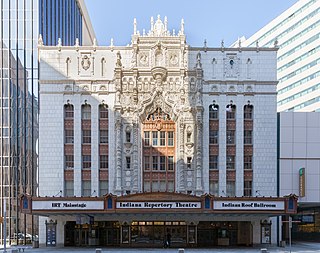
The Indiana Theatre is a multiple use performing arts venue located at 140 W. Washington Street in Indianapolis, Indiana. It was built as a movie palace and ballroom in 1927 and today is the home of the Indiana Repertory Theatre. It was added to the U.S. National Register of Historic Places in 1979. It is located in the Washington Street-Monument Circle Historic District.

The General William Grose House is a historic home located at 614 S. 14th St., New Castle, Henry County, Indiana. It is the home of the Henry County Historical Society. The Italianate mansion was built in 1870 by Civil War Major General William Grose and his wife Rebecca. General Grose commanded the 36th Indiana Regiment and fought in the battles at Vicksburg, Chattanooga, Chickmauga and Atlanta. He resided in the house until his death in 1900. The Henry County Historical Society acquired the 16 room mansion in 1902 and operates it as a museum.

The Porter County Memorial Hall, also known as Memorial Opera House, is an historic Grand Army of the Republic memorial hall located in Valparaiso, Indiana. It was the meeting place of Chaplain Brown GAR Post No. 106, one of 592 GAR posts in Indiana. Designed in 1892 by a local architect, Charles F. Lembke., using Romanesque styling, it was built in 1892–3 to seat 100 people. It was also used as the local opera house.

Boyce Block is a historic commercial building located at Muncie, Delaware County, Indiana. It was built in 1880, and is a two-story, brick building. The building features an elaborate parapet. Since 1904, the building has housed a theater.

West Ward School, also known as the West Building Mississinewa Community Schools, is a historic school building located at Gas City, Grant County, Indiana. It was built between 1900 and 1902, and is a 2+1⁄2-story, rectangular, Richardsonian Romanesque style brick and stone building. It features a symmetrical main facade with round towers at each corner topped by conical roofs. The building houses a museum and community center.
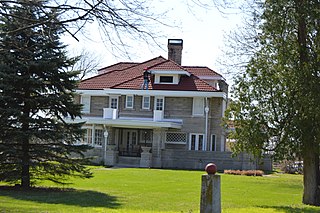
Browne-Rafert House, also known as the Rafert-Anderson House and Browne House, is a historic home located in Fortville, Hancock County, Indiana. It was built in 1914, and is a two-story, Arts and Crafts movement inspired dwelling constructed of Indiana limestone. It has a hipped roof with wide overhanging eaves. Also on the property are the contributing carriage house, small utility building originally used as an office, and perimeter fence, gate, and garden features.
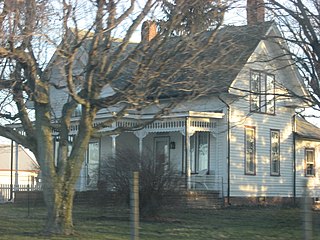
Henry F. Whitelock House and Farm is an historic home and farm located in Harrison Township, Henry County, Indiana. The house was built between 1836 and 1854, and is a 1+1⁄2-story, "T"-shaped vernacular Greek Revival style frame dwelling. It sits on a brick foundation and the original section is of hand-hewn post and beam construction. A front porch was added about 1890. Also located on the farm are a summer kitchen, smoke house, garage, two barns, and a chicken house.

Richsquare Friends Meetinghouse and Cemetery is an historic Quaker meeting house and cemetery located in Franklin Township, Henry County, Indiana. The meeting house was built in 1895, and is a one-story, brick building with a two-story Romanesque Revival style corner tower. A concrete block rear addition was built in 1955. It sits on a limestone foundation and has a steep gable roof. The adjacent cemetery was established in 1832 and remain an active burial ground with over 383 marked graves.
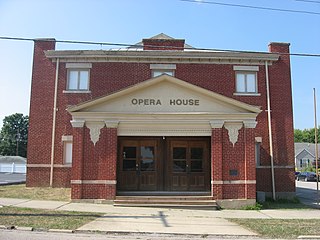
Mitchell Opera House, also known as Mitchell City Hall, is a historic theater building located at Mitchell, Lawrence County, Indiana. It was built in 1905–1906, and is a two-story, brick building measuring 45 feet wide and 85 feet deep. It has a one-story projecting entry, gable roof, and gambrel roof over the stage area at the rear of the building. It housed a theater until 1927, then served as city hall between 1952 and 1979.

Blackstone-State Theater is a historic theatre building located at South Bend, St. Joseph County, Indiana. It was built in 1919, and is a four-story, Classical Revival style brick and terra cotta building. The first floor has four storefronts and the theatre entrance. The upper floors form a loggia that rises to the fourth floor and supported by four pairs of fluted columns. The theater originally sat 2,500 patrons.

Palais Royale Building, also known as the Lippman Building, is a historic commercial building located in South Bend, St. Joseph County, Indiana. It was built in 1922 along with the neighboring Palace Theater by the Palace Theater Corporation. It is a three-story, rectangular, Spanish Renaissance Revival-style brick building with finely crafted terra cotta ornamentation. It features a series of monumental semi-elliptical arched windows. The interior originally housed a two-story ballroom. A bombing on January 10, 1935, blew out most of the storefront windows and destroyed the corner suite.

Sherman Building is a historic commercial building located at Sullivan, Sullivan County, Indiana. It was built between 1926 and 1915, and is a three-story, rectangular, brick building with terra cotta trim. The building housed the Sherman Theater on the first and second floors and offices on the third floor.
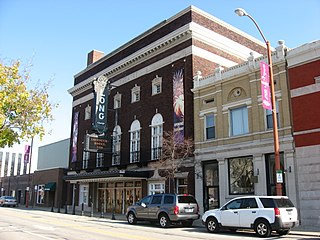
Mars Theatre is a historic theatre building at Lafayette, Tippecanoe County, Indiana. It was built in 1921, and is a four-story, rectangular, Georgian Revival style brick building, with limestone ornamentation and terra cotta panels. It measures 69 feet, 4 inches, wide and 141 feet, 4 inches deep. It was originally built as a vaudeville theater and sat 1,205 patrons. The building houses the Denis H. Long Center for the Performing Arts.

Julian–Clark House, also known as the Julian Mansion, is a historic home located at Indianapolis, Marion County, Indiana. It was built in 1873, and is a 2+1⁄2-story, Italianate style brick dwelling. It has a low-pitched hipped roof with bracketed eaves and a full-width front porch. It features a two-story projecting bay and paired arched windows on the second story. From 1945 to 1973, the building housed Huff's Sanitarium.

Henry F. Campbell Mansion, also known as Esates Apartments, is a historic home located at Indianapolis, Marion County, Indiana. It was built between 1916 and 1922, and is a large 2+1⁄2-story, Italian Renaissance style cream colored brick and terra cotta mansion. It has a green terra cotta tile hipped roof. The house features a semi-circular entry portico supported by 10 Tuscan order marble columns. Also on the property are the contributing gardener's house, six-car garage, barn, and a garden shed.

Henry P. Coburn Public School No. 66 is a historic elementary school building located at Indianapolis, Marion County, Indiana. It was built in 1915, and is a two-story, rectangular, Mediterranean Revival style brown brick building on a raised basement. It has limestone coping and buff terra cotta trim. An addition was constructed in 1929.
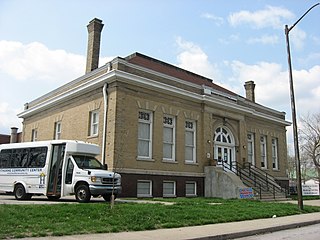
Hawthorne Branch Library No. 2, also known as Hawthorne Education Annex, is a historic Carnegie library building located in Indianapolis, Marion County, Indiana. Built in 1909–1911, with funds provided by the Carnegie Foundation, it is a one-story, rectangular, Classical Revival style brick and limestone building on a raised basement. It has a truncated hipped roof and features a slightly projecting pavilion housing a round arch. It was renovated in 1955, after its closure as a library, and again in 1999.
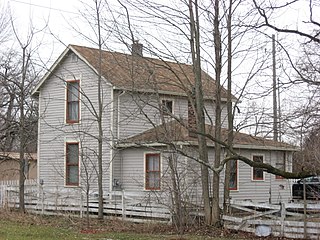
Michigan Road Toll House is a historic toll house located on the Michigan Road at Indianapolis, Marion County, Indiana. It was built about 1850, as a simple one-story frame building. It was raised to two stories in 1886. The building operated as a toll house from about 1866 to 1892. The building was also used as a post office, notary public office, and general store.

Old Indianapolis City Hall, formerly known as the Indiana State Museum, is a historic city hall located at Indianapolis, Indiana. It was built in 1909–1910, and is a four-story, Classical Revival style brick building sheathed in Indiana limestone. It measures 188 feet by 133 feet.

Vurpillat's Opera House is a historic opera house located at Winamac, Pulaski County, Indiana. It was built in 1883, and is a three-story, rectangular, Second Empire style brick building with a mansard roof. It sits on a limestone foundation and features metal decorative details.
























